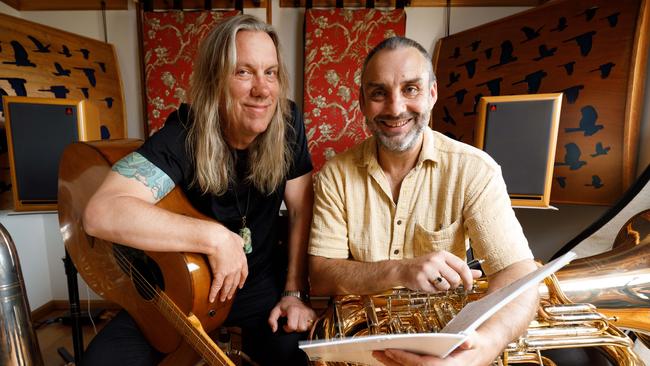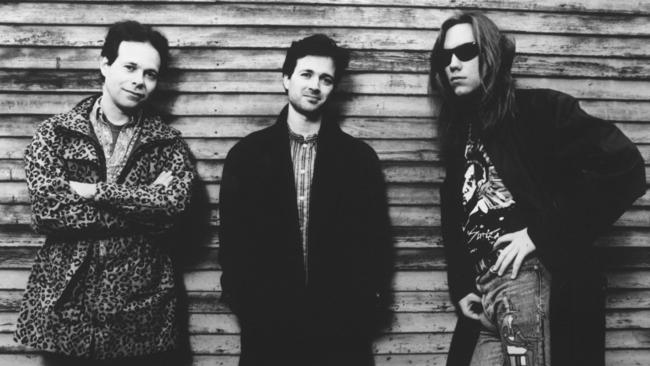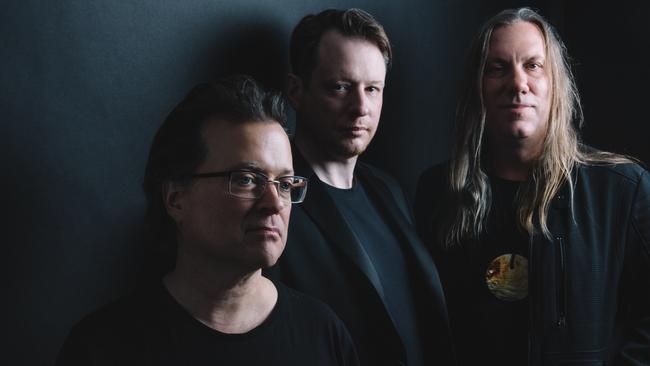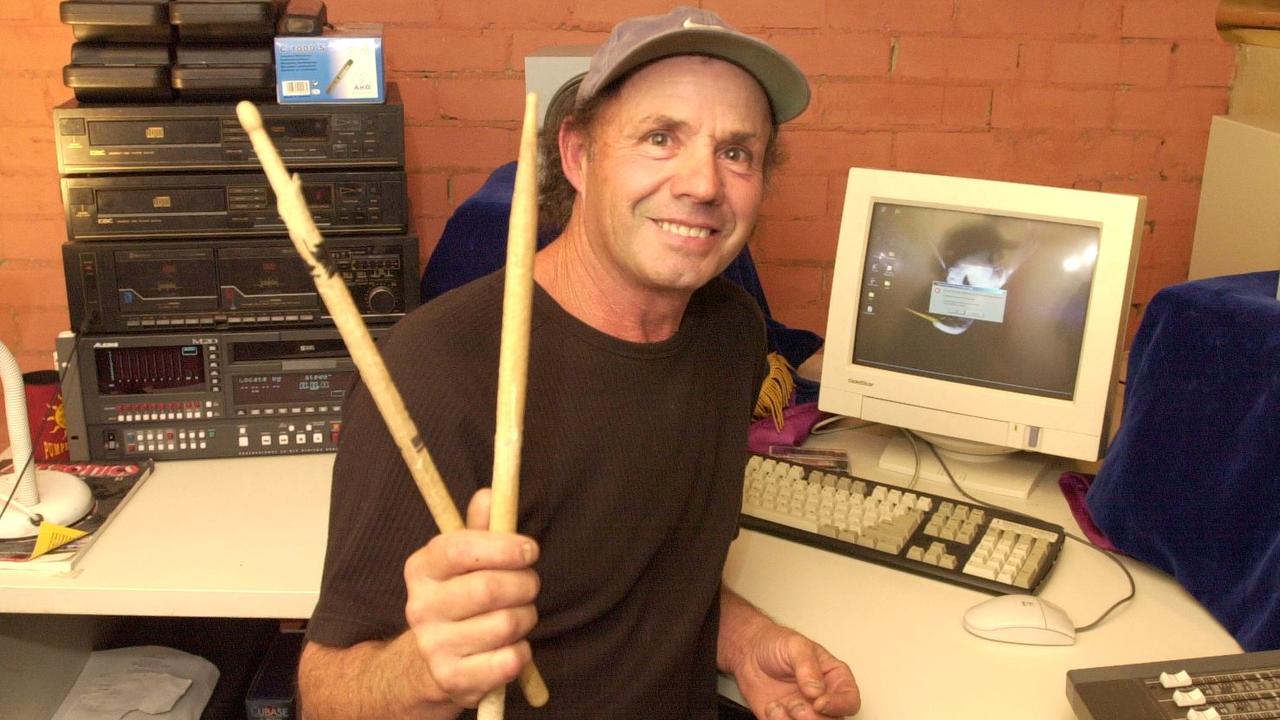Blistering moment in the sun
Classical musicians face the ultimate test as they tackle a punk pearl from the 1980s.

Until recently, tuba player Tim Jones had been suffering through a musical quandary: how on earth do you write an orchestral arrangement for a perfect pop song?
For the past year, the Tasmanian Symphony Orchestra musician has been obsessing over the catalogue of Milwaukee acoustic-punk trio Violent Femmes, his ear turned to writing music for his orchestra colleagues to perform in concert, alongside the band.
It’s the first time Violent Femmes has agreed to work with an orchestra, and for Jones the hardest task was writing an adequate treatment for the band’s best-known single.
“Blister in the Sun scares the hell out of me, because it’s such a monumental song,” Jones says with a laugh. “I tried a few times to have them play that song solo, without the orchestra, but I was unconvincing with my arguments. That was the only one that bothered me, in that sense. I’m thinking of the phrase, ‘If it ain’t broke, don’t fix it.’ It’s quite a pearl, I think: they have many, many fine songs, but that particular song seems to touch a large part of humanity.”
Led by an irresistible guitar riff and a stuttering drumbeat, Blister in the Sun is the first track from Violent Femmes’ 1983 debut album. In the end, Jones reached a compromise with the band whereby the orchestra will stay silent for the first few bars, until guitarist Gordon Gano begins singing the evocative opening lines: “When I go walking, I strut my stuff, and I’m so strung out …”

Jones shares a preview recording of his new arrangement of the song, and it’s thrilling to hear it through a new lens, accompanied by shifting strings and bold horns.
Jones has been principal tuba player with the TSO since 1995. In this role, he has arranged plenty of popular music for small ensembles to play to small audiences, such as for students to perform at nursing homes. He has done nothing on the scale of the Violent Femmes project before, but he has embraced the challenge of augmenting the music of a trio whose instruments include acoustic bass, guitar, banjo and somewhat unconventional percussion. A recent Violent Femmes performance saw John Sparrow tapping his brushes against the hard metal of a barbecue grill instead of drum skins.
“The opportunity to work with such a solid repertoire was an incredible gift I couldn’t pass up,” says Jones, who has arranged about 14 songs to be performed by the 44-piece orchestra. And his own parts? “I’m pretty modest with the tuba playing,” he says. “Having said that, it’s a dirty kind of a band, and the tuba’s a bit dirty, so there’s plenty of fun for me to have.”
If Hobart sounds like a strange place to host a world-first Violent Femmes orchestral partnership, there’s the small fact that band co-founder and bassist Brian Ritchie has lived there for more than a decade. Ritchie also has been music curator for nine years of Tasmania’s annual Mofo festival, organised by the Museum of Old and New Art. The Violent Femmes and TSO concerts, on January 22 and 23, are part of the festival program.
“The genesis of this project is in Brian’s willingness to work with local artists,” says Simon Rogers, TSO director of artistic planning. “He’s always really strong on giving almost equal emphasis to locals alongside internationals, and I really admire that. He’s also a really humble person: it’s hard to get him to program himself. There was quite a lot of arm-twisting involved, I have to tell you.”
The TSO has been a beneficiary of Ritchie’s interest in supporting Tasmanian musicians, and the relationship appears to have been mutually beneficial in recent years. “I think we have a pretty reasonable reputation that we’ll do all kinds of really cool collaborations that other orchestras wouldn’t,” Rogers says. “We put a lot of time, care and effort into collaborating the right way. Perhaps most importantly, the musicians are really happy to take on board all kinds of craziness.”
The Violent Femmes shows will be the TSO’s third such collaboration with contemporary performers. First was a 2015 pairing with American singer and songwriter Amanda Palmer, followed by a 2016 match with Brisbane’s Kate Miller-Heidke. The latter performance won the 2016 Helpmann Award for best Australian contemporary concert, and led to a national tour last year with different orchestras in each capital city.
Ritchie is no stranger to the classical music world and has played acoustic bass, on occasion, with the Australian Chamber Orchestra. “It’s usually crossover stuff I’m doing with them, but within that context there’s always some straight-ahead classical stuff like Vivaldi or Paganini, and to me that’s the fun part,” he says.
“It’s outside of my usual comfort zone. It’s like the forbidden fruit: for the ACO or TSO, playing rock music is like the naughty thing to do. And for me, the naughty thing to do is play Vivaldi.
“But Vivaldi, when you dig into it, has a lot stuff that eventually became part of rock music,” he continues. “Like driving eighth-notes, for example: that’s a real Vivaldi thing, and that’s also the basis of punk rock. Once you’re inside the music, you can usually find some common ground.”

Ritchie also plays Japanese classical music on the shakuhachi, a bamboo flute. “I’m pretty used to grappling with all kinds of different styles of music, and I tend to see the similarities more than the differences,” he says.
“It’s all about turning energy into sound, and communicating with people. That can be on a very basic or a very elevated level, but it’s still the same process.”
The two Hobart concerts will force Ritchie and his bandmates into a predetermined approach to music-making that Violent Femmes has actively avoided.
“This is the first time in probably 30 years that we’re going to stick with a set list,” Ritchie says. “We’ve always been very informal, where I just tell ’em, ‘OK, now let’s play this; let’s play that.’ We free-form it, and usually nobody knows what’s going to come next. But obviously with an orchestra, you have to put the music on the stand in such a way that they can get to the next song without having to shuffle the pages.”
This impromptu approach to live performance has its roots in the band’s beginnings in the early 1980s, when the trio busked on street corners and changed its repertoire on the fly in an effort to attract the maximum attention — and cash — from passers-by.
In that sense, the group has come a long way from the streets of Milwaukee to the calm confines of the Federation Concert Hall in Hobart, where dozens of classically trained musicians will sit behind them, sight-reading arrangements painstakingly crafted by the orchestra’s principal tuba player, patiently waiting for their moment in the sun.
Violent Femmes and the TSO, Federation Concert Hall, Hobart, January 22 and 23.



